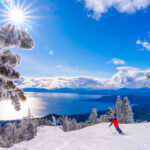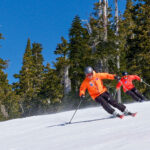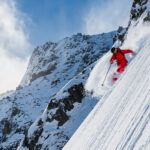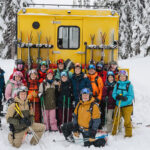The battle to develop and keep life-long skiers rests on the shoulders of Canadian ski areas.
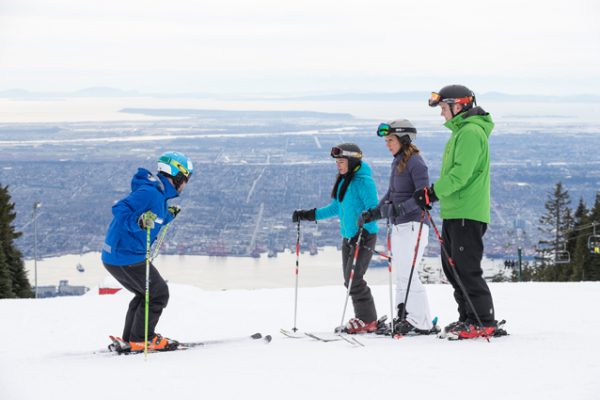
Every year, tens of thousands of Canadians from many backgrounds take a few introductory lessons or join their skiing buddies at a local “feeder hill.” Surveys done for the Canadian Ski Council (CSC) show that less than 18 per cent of skiers who take these lessons (such as the CSC’s Never Ever program) just don’t return in the next year or two. Why not?
“We put skiers into four different buckets: beginners, core, lapsed and revived,” says Paul Pinchbeck, CEO of the Canadian Ski Council. “What the CSC’s research confirmed is that we have a leakage problem, which is marketing speak for ‘people dropped out’.”
Pinchbeck has an aggressive five-year plan—he wants to create a million new skiers by 2025. And he says the CSC’s Model for Growth strategy—adopted last year—is paying dividends. “Before COVID closed ski resorts nationwide, we were right on track. Our estimates show that 170,000 potential new skiers came to our resorts.”
Weirdly, travel restrictions due to COVID-19 might bring lapsed skiers back to the mountains (at least beyond Ontario’s provincial borders, the only region in North America where ski resorts have been shut down). Amanda Harris from Vancouver is one such person. She and her husband, Jim, spend much of the winter in Belize developing recreational property and loving the tropical breezes. But in December Harris was looking forward to time on the slopes again this winter, paying money in advance for an Edge Card before the whole range of COVID-related procedures were announced. Harris said enthusiastically, “I’ve got the snow tires on, bought some used fat skis and am ready for the hills!”
The CSC acknowledges the many challenges that new skiers might encounter, especially if they are recent immigrants or from communities that do not traditionally embrace winter sports. “We want our resorts to mirror the country’s demographic make-up,” Pinchbeck says. “There are many good reasons to embrace winter and to get outside, especially in 2021, given the toll on mental health due to COVID-19 restrictions. We’ll be happy if parents take their kids up for ski lessons and take a walk outside.”
In provinces beyond Ontario restrictions this winter may prove to be a boon to local slopes for learn-to-ski programs and creating awareness of all the fab things you can do on a 100m vertical slope. The CSC runs three different programs that, it’s important to note, are on a national basis. Virtually every ski hill or resort offers a wide variety of lesson programs to get skiers started. “There are many different moving parts that must work together to create a successful ski day, everything from parking to getting your rentals, finding your ski school instructor and figuring out where to go for lunch. Our websites have videos and programs that help new skiers. It’s overwhelming, we understand that,” Pinchbeck explains.
But the rewards are worth it. Indeed, skiing isn’t about keeping score, like tennis or golf, and chairlifts make “getting in laps” much easier than learning the many skills associated with, for instance, backcountry skiing.
Research shows, and Capt. Obvious would agree, that new skiers can feel quite self-conscious while at a resort. Pinchbeck believes that existing skiers have a key role to play in supporting the efforts of novices and lapsed skiers alike. “We’ve found that the number-one reason people ski is because they want to be with their friends. Skills development, fresh air, exercise, mountain scenery—those are all important, but more than anything, skiing is a shared experience, and the best way to be an ambassador for the sport is to introduce a non-skier. At the very least, we’d like to see experienced skiers become more aware of beginners and to engage with them in a friendly manner.”
While retention rates don’t seem great, there is good news on the ski instruction front. Perry Schmunk, managing director of the Canadian Ski Instructors’ Alliance, points to several new developments in how the skiing experience is delivered to every possible range of skier.
Two of the biggest ski schools in Canada—Whistler Blackcomb and Quebec’s Sommet Saint-Sauveur—employ an innovative approach to introductory ski lessons known as terrain-based learning. Rather than having a half-dozen—if not more—students watching an instructor distil the 2020 version of “bend zee knees, five dollars please” wisdom on a rock-hard slope, novice skiers are introduced to the sport by gliding effortlessly—and safely—down a series of artificial features not unlike a scaled-down terrain park.
At Sommet Saint-Sauveur, north of Montreal, first-timers ski through “stations” that provide them with a series of sensations as an alternative to repetitive, rote-style drills. Flexing and absorbing rollers, banking turns through a ski-cross-style course and even riding “switch” in a halfpipe reflect the sport’s reality: that skiers want to ski and not have someone preach at them.
Perhaps because some recent Canadian immigrants are not exposed to winter weather, novice skiers know and trust ski professionals to guide them on their learning journey. They’re much less likely to have friends or family members tell them that “they don’t need lessons” and are more open to learning correct technique right from the start.
Attracting new Canadians to the slopes is often a grassroots affair that can be very specific to one or two resorts. With the assistance of Ski Chantecler and Montcalm in the Laurentians north of Montreal, the non-profit Oui Can Ski program introduces recent immigrants from Israel and African countries like Cameroon and Guinea to skiing—and in many cases snow—for the first time.
Oui Can Ski is the brainchild of Montreal sports agent Sandy Wolofsky. Many of its participants are referred to Wolofsky by Ometz, an employment, immigration and community services organization that provides assistance for more than 13,000 immigrants annually. Participants are bused to the resort and are provided with a lift ticket, equipment rental and two-hour lesson for only $25 per day. Time will tell whether or not they’ll be turned into life-long skiers, but retention isn’t exactly the point—it’s the cultural exchange between world citizens from a variety of backgrounds. Indeed, it’s often the instructors themselves who are the most enthusiastic. Though the sample size is small, Wolofsky claims that almost 40 per cent of Oui Can Ski first-timers return to the slopes again.
In terms of attracting more experienced skiers, the role of instruction goes far beyond the usual “detection and correction” approach that was in vogue back in the ’90s. Schmunk describes the typical ski experience—whether it’s loading everyone into the family SUV or flying across Canada for a week-long ski holiday—as “taking place in a high-stakes environment.” High stakes means more than just the thousands of dollars it might cost to get a family out the door. “There’s a lot at stake to ensure that everyone has a good time,” Schmunk says.
He notes that many resorts are using a consumer-satisfaction tool known as the Net Promoter Score, based on a detailed follow-up questionnaire that guests respond to post-vacation. “There’s nothing that affects a resort’s Net Promoter Score more positively than taking a lesson from the ski school. We’re the people who spend the greatest amount of time with the guest during their stay.” Instructors provide more value than simply passing out tips; their guests receive not only lift-line priority but also reserved seating in on-mountain restaurants and can guide guests of varying abilities onto the proper runs. “We joke that taking a lesson even makes the hamburgers taste better,” he says.
In the early ’80s, advanced and expert skiers cemented their relationship with the sport through Whistler’s Dave Murray Masters Race Camps on a nation-wide recreational racing circuit. Retired forester turned ski instructor Don Heppner works at The Camp, a special four-day program that replaced the Masters racing component with more of an all-terrain mix several years ago. Like the Extremely Canadian off-piste camps that started over on Blackcomb in the early ’90s, Heppner says, “The Camp has an international following, some of who have come back for more than 10 years.” While some technical skills are instilled, its true value comes in pushing skiers beyond their comfort zone through camaraderie and positive group dynamics.
Red Mountain Director of Skiing Mark Impey concurs. “It’s important that skiers developing their skills know that they’re far more capable of breaking through to a new level than they might think.”
Even the 80 per cent figure might be misleading since tens of thousands of kids learn to ski and snowboard through both the CSC’s SnowPass program and a wide variety of bus tours organized by local schools. Again, these programs are designed to be as affordable as possible, but from hockey to music, gymnastics and swimming, there’s an enormous number of sporting and academic activities in which kids can be enrolled.
It’s worth noting that many childhood activities—so much time, so many lessons and camps to attend—don’t remain with us into adulthood. To describe skiing as “just another sport” is to deny its lifetime value in terms of thrill runs, mountains gazed upon, and friendships made. Skiers—especially the fanatics among us—can do our part by spreading the word and sharing the stoke to raise that retention rate to a hundred per cent. Most of us can’t imagine life without skiing.
by STEVEN THRENDYLE in WINTER 2021 issue
